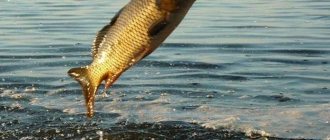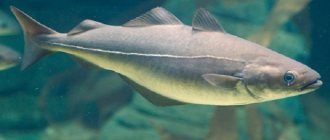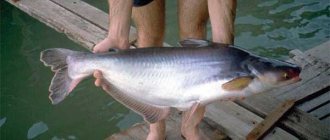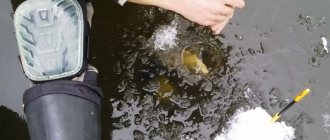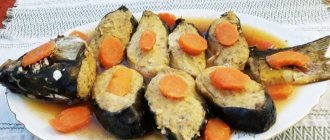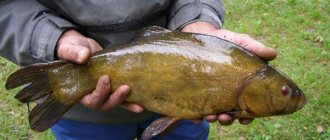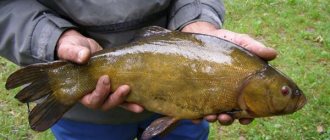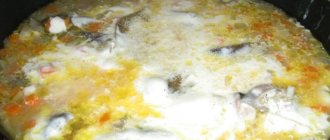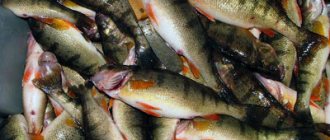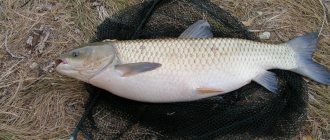Despite the fact that tench cannot be called rare, it is difficult to catch. This can only be done if you thoroughly study the habits and lifestyle of this mysterious fish. Anyone who manages to catch this hermit will receive a healthy and tasty delicacy on his table.
| Class | Ray-finned |
| Squad | Carp-like |
| Family | Carp |
| Genus | Tinca (sole representative) |
| View | Tench |
| Security status | Listed in the Red Book: -Germany -Irkutsk region -Yaroslavl region -Republic of Buryatia |
| The average size | From 20 to 70cm, up to 7.5kg. |
| Lifespan | Up to 16 years old |
| What does it eat? | Bottom invertebrates (insect larvae, worms, mollusks), aquatic plants, detritus |
| Optimal feeding time | Evening |
| Enemies | Burbot |
| What do they bite on? | On an earthworm |
Where is tench found in Russia?
Tench is a fairly common fish. Its habitat is the European part of Russia. On the Asian part, beyond the Urals, tench is less common. The border of the continuous habitat of this fish runs along the course of the Yenisei. Since this representative of carp species is dependent on environmental factors, it is practically not found in eastern Siberia and Lake Baikal.
If there is standing water in a reservoir, overgrown banks and a muddy bottom, then most likely there is tench there. Prefers moderately warm water temperatures, avoiding cold springs and rapids. Thus, well-warmed small lakes, ponds, creeks, and river channels with a quiet flow are the most favorite places for tench.
Tench usually stays near high steep banks overgrown with reeds and algae, hiding between snags and mud. Excellent tolerance to low oxygen content in water. It never migrates, preferring a solitary, measured lifestyle in familiar places. With the onset of winter, it buries itself in the silt and falls into suspended animation until the arrival of spring warmth.
Features of character and lifestyle
Photo: Golden Tench
Tench, unlike its carp relatives, is characterized by slowness, clumsiness, and unhurriedness. Tench is very cautious and timid, so catching it can be difficult. Once caught on a hook, his whole being changes: he begins to show aggression, resourcefulness, throws all his strength into resistance and can easily break loose (especially a weighty specimen). This is not surprising, because when you want to live, you won’t be so busy.
Tench, like a mole, avoids bright sunlight and does not like to go out into the light, staying in secluded, shady, aquatic thickets in the depths. Mature individuals prefer to live completely alone, but young animals often form schools of 5 to 15 fish. The tench also looks for food at dusk.
Interesting fact: Despite the fact that tench are inert and inactive, they make feeding migrations almost every day, moving from the coastal zone to the depths, and then again to the shore. During spawning, he can also look for a new place to spawn.
In late autumn, tench burrow into the silt and fall into suspended animation or hibernation, which ends with the arrival of spring days, when the water column begins to warm up to four degrees plus. Having awakened, tenches rush closer to the shores, densely overgrown with aquatic vegetation, which they begin to feed on after a long winter diet. It has been noticed that in extreme heat the fish becomes lethargic and tries to stay closer to the bottom, where it is cooler. When autumn approaches and the water begins to cool a little, tench are most active.
General description and characteristics
Despite the fact that tench belongs to the carp family, it is not at all similar to carp. Rather, it can be confused with ide, which has a similar body structure, but lighter scales, devoid of mucus.
What does tench look like? The fish has a golden-olive color on the sides, turning into dark green or black toward the back. The abdomen has a grayish-yellow tint, and the fins are always dark. The body of the fish is covered with a thick layer of mucus, which quickly coagulates and peels off when exposed to air.
Important!
If the fish lives in a transparent reservoir with a sandy bottom, then its color becomes light golden. Living in a lake or river with a muddy or peat bottom, tench acquires a dark or even black body color.
Like all representatives of the carp family, the head of the tench is small, and the gill slits have 20 rakers. The eyes are red and small in size. The mouth is small, slightly turned up. The lips are fleshy. It has one row of teeth, the teeth at the ends are curved inward. On the jaws there are small, extremely sensitive antennae that compensate for the fish’s poor eyesight.
The tench's scales are small, very close to the body. The tail is wide with a slight truncation. The wide back fin, as well as the short tail fin, have a rounded shape, without a notch. The tench's pelvic fins tend to grow throughout their lives. The older the individual, the longer they are and can reach the anal fin. (photo).
Tench is a royal fish.
Tench is a royal fish.
Why, in fact, is this tench the king fish? There may be several reasons for this. Firstly, the coloring of the tench gives off an antique gold feel. Truly a noble color. The body of the tench is dense, fleshy, thick - a real aristocratic body, who understands fish. Tench is a less common fish than roach, bream, and carp.
Fishing for tench is a special pleasure. Tench loves quiet places overgrown with reeds and reeds, but almost never smells of mud. Tench should be fed moderately, in small portions, avoiding oversaturation. You can fish with a regular float rod, throwing the bait closer to the reeds, into the “windows” of clean water. Tench is a cautious fish, so the leash should be from 20 to 30 cm, transparent, made of monofilament. Tench is most often caught using a red dung worm; crayfish and bloodworms are very suitable. The tench’s love for cottage cheese, but not sour one, deserves special attention. Bait is made from it, mixed with bread, and added to bait. There is a known method of catching tench using a bait made from rotten cottage cheese mixed with white bread crumb. At first, the tench only sniffs the bait and slightly tastes it with its lips. But if it bites, it bites, it’s a pleasure.
Tench meat is known not only for its rare taste, but also for its healing properties. Previously, its decoction was used to nurse seriously ill people whose bodies could no longer digest other food. Other fish are also suitable here, but tench is still the best.
As for healthy eaters, one rare quality of this truly royal fish is worthy of attention: it can be fried without peeling. Tench's scales are very small and delicate - in this case, a crispy golden crust is formed, whose lovers even consider it truly barbaric to clean this wonderful fish in all respects before frying it.
And finally - two culinary recipes: for tench - bait and, in fact, for the fisherman - from tench. Bring the curd mass in a warm place until it is slightly rancid, but so that it does not have a pronounced sour smell. Thoroughly mash the cottage cheese with the pulp of white bread in a ratio of approximately 1:3. Make balls approximately 0.7 mm in diameter, and lightly “grab” them in the oven to bake the crust. You can make boilies. Store in the freezer.
Gut the fish without cleaning it. Sprinkle the fish with salt, pepper and sugar to taste. Sugar will improve the crust. Let the fish lie for about 10 minutes. Roll in flour and fry until golden brown.
Share with friends:
Date of publication: 08/07/2014
Add a comment Cancel reply
What do tench feed on?
Tench is one of those fish that prefer to get their food in the evenings. With the onset of dusk, the tench begins to actively dig the bottom in search of food. Everything is eaten: swimming beetles, leeches, mosquito larvae, insects flying above the surface of the water. Tench does not disdain grass and mud. Organic remains of invertebrate animals - detritus - are also used as food.
When night falls and the water in the reservoir gradually cools, the activity of the fish decreases sharply. Then the tench falls into a state of rest, settling in secluded places on the muddy bottom or among snags.
Important!
Tench is one of the most peaceful fish. But if the reservoir where it lives is not rich in nutrients, then the tench can exhibit predatory tendencies, eating the young of other representatives of the carp family.
Habitat
Those planning to catch tench need to know where the fish live and where to catch them. This interesting representative of the ichthyofauna prefers a temperate climate, stagnant waters and areas with weak flows (the basins of the Azov, Black, Caspian and Baltic seas).
The abundance of food and the presence of natural protection in the form of thickets of reeds or reeds attract tench to a permanent place of residence. It can feed on both algae and grass, as well as small neighboring inhabitants (leeches, beetles, worms, larvae, as well as insects flying into the pond).
It does not disdain food used for catching and breeding carp. It is very fond of mosquito larvae, which it primarily feeds on after hibernation.
The appetite usually wakes up when dusk comes. At this time, tench can intensively dig the bottom in search of food. When the water temperature begins to drop below +10, it stops its activity, falls into torpor (anabiosis), and stops looking for food.
Late evening or early morning is the ideal time for fishing.
Reproduction process
The ability to spawn in tench occurs at 3-4 years. One of the conditions for the start of spawning is water heated to 17-190C. Typically, spawning begins at the end of May and lasts for eight weeks. During this period, tench break their usual solitary lifestyle, gathering in groups.
For spawning, females prefer spawning grounds with clean, weakly flowing water. The depth, however, does not exceed 1 m. This process lasts 2-3 times at equal time intervals. Depending on the age of the fish, the number of eggs can vary from 50 to 600. The larvae attach to the roots and stems of underwater plants.
Tench caviar is very small and has a light green tint. If the water is heated to more than 200C, then the incubation period lasts no more than 4 days. Then the larvae appear and a long period of development begins. After hatching, the fry gather in small flocks. The food supply for the growing juveniles is plankton and algae.
This is interesting!
Tench is a slow growing fish. During the first year of life, the fry can grow up to 5 cm. It takes 5 years for the tench to reach a length of 20 cm.
Tench feeding
When the water in a river or lake warms up to + 5 – 7 degrees, individuals begin to awaken. It is during this period that they develop an active appetite associated with preparation for spawning. What does tench eat?
In general, tench prefers:
- small worms found at the bottom of the reservoir;
- insect larvae;
- small plants;
- accidentally dropped cereal seeds;
- phytoplankton;
- water beetles;
- snails;
- bloodworms;
- all kinds of bugs.
Such fish feed exclusively before dawn or late in the evening. During the day they do not leave their shelter and hide from the sultry sun.
Varieties of tench
- River. Unlike the lake one, it has a smaller build. The mouth is more pronouncedly turned upward. The color is darker. Usually avoids places with intense currents, hiding in quiet bays;
- Ozerny. The largest among his fellow tribesmen. It has a light golden body color and a silver belly;
- Pond. This tench is slightly smaller than the lake tench. Feels great in artificially created reservoirs and small natural ponds;
- Golden. A decorative variety that appeared as a result of the work of breeders. Has a golden color. There are clearly visible spots on the sides. Eyes are dark in color.
Tench spawning
This fish is a heat-loving species, so tench spawning begins after May 15–20, when the water warms up to 18–20 degrees. During this period, they move to shallow areas with dense vegetation. Here fish gather in small schools consisting of 3 – 5 males and one female.
Unlike other representatives of cyprinids, they spawn silently and do not give themselves away by splashing water or diving to the surface. In general, tench spawning lasts 10–14 days; with a sudden cold snap it can last up to three weeks.
Distinctive features of tench spawning include:
- the ability of a female tench to lay 300 – 350 thousand eggs;
- the duration of egg ripening is 3 – 4 days;
- the emerging young remain in the thickets and feed on zooplankton.
Interesting fact:
65–80% of the eggs become food for other aquatic inhabitants and birds.
Enemies of tench
The solitary lifestyle of this fish does not imply the presence of any significant threats from other inhabitants of the reservoir. For some reason, predators like pike and perch do not prey on tench. This may be due to the fact that the mucus that covers the fish disgusts them.
Burbot, which, like tench, is a bottom-dwelling fish and prefers to feed during evening twilight, is the only significant threat to tench. Competition for food, as well as the fact that burbot is not averse to feasting on the young shoots of molts, forces the tench to avoid its habitat.
A significant danger to tench is posed by poachers, who can completely destroy the population of this fish in a reservoir.
Important!
Unlike adult tench, its eggs often become prey for other aquatic inhabitants, since the spawning area is not protected by parents. Despite the fact that the number of eggs laid can be quite large, a small part of it survives to become an adult fish.
Tench, a special fish
Tench is an extraordinary fish, which is called the fat man in the axamite robe. Tench lives in shallow reservoirs with a muddy bottom and overgrown with aquatic vegetation. The fish is very cautious and shy. Tench is not a “glutton” fish; it feeds in the morning and evening at certain times (depending on the time of year and the reservoir). Despite the fact that tench stays in hard-to-reach places overgrown with algae, despite its innate caution when collecting food, it still goes to the feeding areas of other fish species, where it is caught by fishermen’s bait.
Tench has delicious meat, and there are many connoisseurs of it in our country. This causes massive influxes of fishermen into those reservoirs where more or less constant tench biting is observed. Fisheries advertise here and there. Many fish farms involved in tench breeding have tried their hand at fishing for tench.
In addition, poaching poses serious problems for the normal survival of this beautiful fish. Fishermen, unfortunately, rarely release large specimens of tench. We can release a good, large carp or carp, but we will never release a good tench. As a result, the number of tench weighing over half a kilo decreased, and in some places almost completely disappeared from the catches of fishermen in most of our lakes. And where such specimens are still found, there is an increased concentration of amateur fishermen. This inevitably leads to a further decrease in the number of large tench specimens.
The problem with tench is its relatively slow growth. You can try to stock any body of water with this species by releasing fry there... Believe me, many enthusiasts have tried to do this, for example, in abandoned quarries. As a rule, these attempts did not lead to a successful outcome. Before reaching a decent size, this species is mercilessly exterminated by the usual predators of Polish waters - perch and pike. The survivors remain a rarity that faces a severe struggle for its existence with other fish species. And its competitors are not weak: crucian carp, carp, silver carp and grass carp, which are especially active in destroying the natural habitat of tench.
Numerous pond farms cannot reverse this situation. Of course, it is much more profitable for the owner of such a pond to introduce carp into the pond, which in two years, with normal nutrition, will reach quite a trophy size. This will attract a large number of anglers to the reservoir. And here is the tench. Well, it doesn’t grow quickly in our conditions. He doesn't have such an opportunity.
In the EU, there are restrictions on the size of fish caught. But we understand that the introduction of such a principle is an attempt to calm our conscience. We are not Europe; our geoclimatic conditions are different. Not a single fisherman who catches a tench smaller than expected will ever let it go, just as he will decide whether to buy an echo sounder or not. Even under the threat of a large fine. This is not in our tradition. The fate of brook trout is a case in point. No fines stop the specialists who track down this cautious and cunning fish in the border streams of Poland.
Lin clearly deserves more of our attention and much better protection than ever before. This fish cannot exist only within artificial ponds. This is one of the pearls of our common hobby, and one of the most beautiful fish in our waters.
If we want to continue to fish for tench in our waters, we must take serious steps to protect them. Firstly, try to limit the catch of large tench, in large quantities. We must also protect tench during the off-season and during spawning.
In Poland, for example, there is a serious debate that tench longer than 25 cm and weighing more than 0.5 kg should be released unconditionally. Motivating this is that females of this size and weight can lay about 300 thousand eggs during the spawning period. At the same time, it is proposed to limit the daily catch to two specimens. I agree with this, although I would make some changes to the sizes offered by my Polish colleagues: from 25cm to 35cm.
Tench spawn several times during the summer season. Spawning occurs from mid-June to late July. The introduction of a ban on tench fishing from June 1 would give the tench the opportunity to calmly spawn.
Tench spawn several times during the summer season. Spawning occurs from mid-June to late July. The introduction of a ban on tench fishing from June 1 would give the tench the opportunity to calmly spawn. I believe that the period of such a ban should last until August 10, so that after spawning, which will last until the end of July, the fish could rest. I watched the video of the Shcherbakov brothers. These first days of August are a period of intensive feeding, which allows you to replenish the body's resources lost during spawning.
When it comes to fishermen, they are far from happy with such bans.
They believe that there is no reason for such special attention to the fate of the tench. I understand them. It would just be a shame to lose this handsome man completely. It is almost impossible to find golden crucian carp, Baltic salmon or grayling in our area anymore. And what? Shall we also add tench to the Red Book? Will we show it in pictures to our children and tell our great-grandchildren stories about how this beautiful, strong fish bit and how tasty it was? Yes, the situation is not yet critical. You can try breeding tench in specialized ponds, as is done with brook trout. We can involve ichthyologists and, to some extent, geneticists in this, in order to create a more stable species of fish, adapted to our conditions. But it is simply necessary to do something today. Share on social networks:
Diseases
Thanks to the unique chemical composition of mucus, which abundantly covers the entire body, tench is resistant to most diseases that affect the carp family. Diseases such as dactylogyrosis, rubella and other parasites are not scary for him. However, tench can be infected with opisthorchiasis.
Unfortunately, it is impossible to determine infection in fish by eye, so before eating you should resort to one of the following measures:
- deep freeze;
- pickling;
- heat treatment.
The benefits of meat
Freshwater tench meat is considered dietary, as per 100g. accounts for only 45 kcal. Nutritionists advise regularly eating this fish for people with high blood cholesterol and those who have diseases of the cardiovascular system.
Tench meat contains a number of important microelements: potassium, magnesium, sodium, copper, zinc, fluorine, chromium, manganese. Fish contains vitamins A, E, C. The high protein content allows tench meat to be included in the diet of children and athletes. Iodine, which fish meat is rich in, has a beneficial effect on the functioning of the thyroid gland.
This is interesting!
In Rus', it was believed that tench could cure jaundice, and healers treated wounds by applying a fish carcass cut in half to them.
Useful properties of tench
Composition and presence of nutrients
Despite such a low calorie content, tench is very rich in various vitamins and nutrients. This fish contains high-quality protein, iodine, vitamins B, A, E, C and PP. It also contains zinc, copper, sodium, chromium, polyunsaturated fatty acids, phosphorus, fluorine, manganese and potassium.
Useful and healing properties
Tench is one of the few products that contains high-quality protein, which contains essential amino acids. Doctors strongly recommend eating tench for people who complain of poor stomach function or problems with the thyroid gland. Scientists have proven that if you systematically consume cooked or baked fish, it will have a beneficial effect on the body as a whole. Tench has the greatest effect on the functioning of the heart, namely, it prevents the occurrence of arrhythmia.
In cooking
It should be noted that tench is not suitable for food during the spawning season. Fish caught at the end of April or at the beginning of May has the highest taste quality. This species prefers to live in swampy or musty water, so the meat smells of mold and silt. But this can be easily corrected by placing a still living tench in a bath of water, or keeping it in running water for 12 hours.
Tench is suitable for preparing a wide variety of dishes. It can be boiled, fried, baked, stuffed, stewed, pickled, cooked in sour cream or wine. It should be noted that it makes excellent jellied meat.
Properly cooked tench is comparable in taste to chicken meat, and even its skin resembles the appetizing skin of birds.
Dangerous properties of tench
The only caveat is individual tolerance, but this happens quite rarely.
Here is a wonderful tench recipe. Most of the ingredients are always on hand, so housewives should take note.
Author: Lyudmila NK
Description: Tench is a unique, interesting, very tender and tasty fish; it was not without reason that it was served at the royal table. If the Tsar Father himself tried this, why shouldn’t we try it too.
Tench fishing
To catch this mysterious inhabitant of rivers and lakes, you need to work hard. First of all, you need to understand where, most likely, he can hide. You should look for thickets of reeds, quiet creeks with a slow current, and a muddy bottom.
Typically, the molt feeds at a depth of 0.5 to 1.5 m, collecting aquatic insects, snails, mosquito larvae and dragonflies. This means that the gear needs to be cast closer to the shore. A 4-5 meter rod is quite suitable.
Tench is a shy and cautious fish, which means that in order not to frighten it away, you need to remain quiet. After the first tench is caught, it makes sense to spend some time so that the other fish calm down and, at the same time, provide additional feeding.
Gear for catching this suspicious and timid aquatic inhabitant should not be rough or massive. The best choice is a durable fly float rod equipped with a strong fishing line of small diameter.
Spawning period
Spawning of tench, depending on the location of the reservoir, usually begins in the middle or end of May. At this time, tench completely stops being caught and a few days before the start of the games, it goes to deep places, hiding in the mud.
Spawning is of a group nature; the group, as a rule, includes several males and one female. In those reservoirs where there is little tench, its spawning takes place almost unnoticed, unlike other species of fish.
The process itself is quite long, first of all it begins in smaller individuals, then it is the turn of larger fish. It usually takes place in the morning, in calm, warm weather. The number of eggs is very significant; in an adult it can reach several hundred thousand. They are very small in diameter and have a greenish color. Under favorable conditions - stable weather, when the temperature is about 22-25 degrees, the eggs develop very quickly and in less than a week the juvenile tench appears.
At first, molts feed exclusively on zooplankton, staying in schools closer to the bottom, in the very thick of aquatic vegetation, due to which they are rarely attacked by predators.
However, despite all these factors, tench is not widespread and this can be explained by the fact that a significant part of the eggs becomes prey for other fish, birds and aquatic insects. In addition, the number of tench is greatly influenced by the burbot, which also stays in the bottom layer, and at night often goes out into the nearest bays, where there are many young moults.
Juvenile tench grow quite quickly and after 2-3 years reach a weight of 400 grams or more, and under favorable conditions they can grow up to a kilogram.
What is the best way to catch tench?
The best bait for molts is a common earthworm. The main condition is that the bait should be small and not cause any suspicion in cautious fish.
Important!
The place where the fish is located can be detected by characteristic bubbles rising from the bottom. Among fishermen, this phenomenon is called “line passage” or “line path”.
My favorite fish is tench
Photo: Andrey Yanshevsky.
One of the most “sure” signs about the beginning of the spring bite is the appearance of young shoots of aquatic horsetail above the surface of the water.
Tench chooses a feeding area of the reservoir, which can be characterized by the following signs.
Depth 1-1.5 m, presence of silty soil with a large “content” of bloodworms, absence of current, but sufficient rate of water exchange.
Water exchange is ensured in lakes and ponds either from the flow of an inflowing stream, or due to a surge wave.
In rivers these are bays, often quite small in size.
A good sign of a linear place is the yellow capsule.
Another important factor is the presence of vegetation on the bottom.
Personally, I choose an area where there are no filamentous algae on the bottom. Clearing the bottom never led to a positive result, even if I removed the algae very carefully without touching the silt itself.
It seems to me that the well-known “nomadic literary” advice about preparing the “table” might be needed if I were engaged in attachment. But I don’t see the point in this.
Read the material “Mallard ducks love to eat berries”
As a rule, tench have enough natural food and the role of bait is not as significant as for bream or crucian carp.
I see the role of bait only as holding back the tench for a short time. In the morning the fish moves along the thickets of vegetation along its “trodden” path. When encountering bait on the way, the tench may stop and stumble upon the bait here.
The bait used when fishing for bream, roach or crucian carp is ineffective. Standard broad-spectrum baits are finely dispersed, and with tench the rule: “big mouth, big piece” applies literally.
The volume of bait should be enough to cover a fishing area of approximately two square meters. The bait, despite the shallow fishing depths, should not produce turbidity - tench do not like this.
I use three or four large handfuls of crumbly millet porridge, with the addition of a tablespoon of vegetable oil, two tablespoons of sugar, a handful of ground cake and a handful of washed cottage cheese.
You need to approach or swim to the fishing spot and lower the bait directly to the points where the bait will be located. And this must be done at least 2-3 hours before the start of fishing.
I consider the dung worm to be the best known bait. Specimens about 5 cm long are selected for fishing. Worms need to be collected before fishing in order to maintain their activity.
| Photo: Andrey Yanshevsky. |
I plant four worms across the body in a row, additionally covering the hook barb with one or two maggots. The maggot prevents the worm from flying off the hook, especially during casting. If there are no dung worms, then you can use red underleaf. But it is significantly less hardy than dung.
Read the material “Catching rotan with a spinning rod”
Another interesting bait is maggot. At least 7-8 pieces should be placed on the hook. It is very important that the hook is not only sharp, but also durable. Tench resists more than carp.
When designing equipment, I proceed from the fact that the bait should lie motionless on the bait spot, or drag at a minimum speed (approximately at the speed of a worm crawling along the bottom).
You need a long leash, about half a meter. A heavy bait in the form of a bunch of worms holds the entire equipment like an anchor.
During those hours when tench are most active, the weather is usually close to calm.
Where I fish, you need to hunt for large tench from four to seven in the morning.
The fishing distance with float equipment, taking into account the shallow depth and caution of the fish, is at least 15 meters, the weight of the equipment is from 3 to 8 g.
Relatively heavy equipment is mounted on a fairly thick and strong fishing line (at least 0.18 mm). A safety margin is needed in case the hooked tench starts to “mow” the leaves of the egg capsule with the fishing line. By the way, I have not noticed that in the spring a large tench is afraid of a 0.25 mm fishing line - it is important that it is soft.
Loading scheme - the main sinker in the form of a sliding olive with a stopper and a heavy support (approximately 0.5 g).
A large bait of four worms does not sink even in soft mud. And even if she drowns, the tench will still find her.
Read the material “Catching ide. The best attachments"
After measuring the depth, I distribute the weights and make several casts. If the equipment stands still and does not move to the side, then I reduce the descent by one or two centimeters and so on until the equipment begins to slowly move to the side. I bait the worms and cast.
If, during the process of fishing with a change in the surface current, the equipment suddenly begins to drift away, then you need to immediately add a descent, by 2-3 cm. An extra 3 or even 5 cm will not hurt, as long as the bait (but not the sub) lies on the bottom.
Tench fishing hours coincide with hours of limited visibility. Therefore, and even taking into account the massive bait on the hook, it is necessary to use floats with thick floating antennas.
When fishing from the shore in narrow oxbow lakes and channels, I use plug gear. The plug is convenient for silently lowering the nozzle directly onto the bait and holding it there. Excellent results are obtained by fishing with a plug with equipment without weight.
If the weather does not allow fishing with a float rig, then a light picker helps out.
The bait is guaranteed to lie on the bottom and is not carried away by the bottom current and wind.
I strive to make rigs that are as thin and light as possible, to the point of demolition. The choice of fishing line in terms of strength depends on how realistic it is in the given conditions to quickly move the fish away from the vegetation.
Personally, I prefer not to use a feeder, but to fish, as with a float rig on a spot of bait, which can be easily created using a slingshot. The fishing distance can be very short - 20-30 m. Then the bait can be thrown by hand.
Read the material “In spring with Bolognese equipment”
Fishing begins with the weather forecast. If the weather is expected to change in a day, then it is better to tune in to catching different fish.
| Tench have begun to be released into carp fields, but they are small here. Photo: Andrey Yanshevsky. |
When there is a weak wind blowing in a constant direction, it is more difficult to fish because you have to use heavier equipment to prevent the bait from drifting. The graze sometimes has to be placed on the bottom, which reduces the sensitivity of the gear.
The early stages of the bite are difficult to see, and you need to pay closer attention to the behavior of the float. Sometimes you even have to use a sliding sinker lying on the bottom. But, despite the difficulties, fishing can be successful, although not as effective as in calm weather.
From the accumulated statistics, I made another conclusion: in windy weather, more “trophy” specimens still came across.
Tench fishing requires absolute silence; you cannot stomp, knock, or throw anything onto the shore or into the boat.
The appearance of tench on bait can be seen from the behavior of the float. He begins to move, spin, and sway imperceptibly. Most authors writing about tench interpret this phenomenon as fish tasting bait. I don't think so.
Tench, walking along the path, encounters bait. Stopped by the smell, the tench begins to look for food, which has partially or even completely gone into the mud, and gradually or immediately stumbles upon a tasty worm. But before the line hits it, it makes a sufficient number of body movements that can move or shake the equipment, which is what the float shows.
The long and tedious “body movements” of the float, in my opinion, only indicate that the tench cannot dig up the bait, or it is simply not interested in it. In such cases, I change the bait to fresh one. This usually leads to an immediate bite.
In the overwhelming majority of cases, a large tench takes the bait entirely with its rather large mouth and continues to move along the path, while the float sometimes sinks, but more often moves to the side. After the fish has walked about a meter, but not before, you can safely hook.
Read the material “Tick: how to protect yourself and what to do if bitten”
If one or three bites are observed in one place one after another and the floats have completely calmed down, it makes sense to temporarily change the fishing point. After the bite subsides in a place where there were bites, but not a single fish was caught, the bite usually resumes after 20-30 minutes.
At the point from which the fish was caught, and after that there was silence, the bite usually resumes after an hour.
After a successful hooking, the tench rushes into the nearest thicket of plants and, if this is allowed, it will not only go into the grass, but may also rest its nose on the bottom of the nearest hummock. To “rip it out” from there you will need catfish class tackle.
If this does happen, you will have to wait. Attempts to knock on the rod or on the stretched fishing line lead to nothing - the tench continues to stand to death. Conclusion: you need to have a spare rod equipped.
Large tench are caught consistently only a few days a year, only in specific places and in very short periods of time, but even one three-kilogram specimen is worth hunting for.
Andrey Yanshevsky May 8, 2021 at 12:28 pm
Gastronomic features
Before cooking this fish, you need to get rid of the mucus. You need to rinse the carcass well under running cold water, pour boiling water over it, and rinse again. In this case, the mucus will coagulate and be easily removed. You can easily get rid of the smell of mud by soaking the fish in a saline solution.
Like all representatives of cyprinids, tench is a bony fish. Therefore, it is worth choosing specimens as large as possible. When cleaning it, you should carefully remove the gallbladder without damaging it. Otherwise, the meat will acquire an unpleasant bitterness and will be unedible.
Many tasty, dietary and, at the same time, nutritious dishes can be prepared from tench. The meat of this fish has a sweetish taste and is excellent for frying, baking in the oven, preparing aspic and fish soup.
Catching tench is an exciting activity, similar to a difficult but interesting quest. Catching this cunning and cautious loner is a great success. And a dish prepared from this fish is a real pleasure for a true gourmet.
What are the benefits of tench fish?
Not every representative of freshwater fish can boast of the chemical composition found in tench meat. Thus, the tench has:
- high-quality easily digestible protein;
- fats;
- polyunsaturated fatty acids;
- all essential amino acids;
- vitamin A (retinol);
- ascorbic acid (vitamin C);
- tocopherol (vitamin E);
- vitamins from group B (riboflavin, thiamine, folic and nicotinic acids);
- macroelements represented by sodium, magnesium, potassium, calcium, phosphorus;
- the main minerals are zinc, iodine, iron, chromium, copper, fluorine and manganese.
The calorie content of 100 grams of meat from this fish is only 40 kilocalories.
The energy ratio of proteins, fats and carbohydrates is 70/41/0%.
